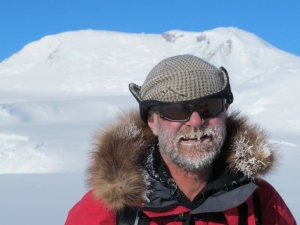No Mount JohansenIt isn’t possible to write today’s text without expressing our gratitude to Alse T. Johansen’s expedition. They struggled manfully up the slopes, leaving wonderful tracks behind them!
“Fairly violent gusts of wind from the N. quarter during the night. As usual we were on our way around 8 ‘oclock. But the weather was not of the best kind. Fog and snow. A little sun now and then.”– Amundsen on this day 100 years ago (Read more …) 
We have now left the Axel Heiberg Glacier and are moving onto the South Polar Plateau. We have a campsite at about 2600 metres elevation and are extremely pleased to have most of the altitude under us. We have also left behind the two mightiest mountains, Fridtjof Nansen and Don Pedro Christophersen. Polar naming is interesting. Maps can reveal a lot about who explored a region and what signals the explorer wanted to send. Polar place names reverberate with history, cultural heritage, and political interests. There has often been a desire to put a national imprint on a region as a way of strengthening territorial claims. We have studied our maps carefully and found that many of the names the expedition team used in their diaries were eventually superseded by other names. Don Pedro is one example. It is unlikely that any of the five skiers spared a thought for the Norwegian landowner in Argentina as they struggled up these slopes. But when Fram came back to the Bay of Whales and Captain Thorvald Nilsen explained how Norwegian-Argentinian Don Pedro had saved the expedition from financial catastrophe, Amundsen felt obliged to rename the mountain he had originally given the patriotic name Håkonshallen. We note that Prestrud and Stubberud have been given peaks in this area. Two of the three who were not included in the team that made the final onslaught to the South Pole after the first, abortive attempt. But Hjalmar Johansen was not given a geographical monument. His betrayal was too great, according to Amundsen. Johansen had criticised Amundsen for having started too early in the season. Johansen – who probably saved Prestrud’s life and thus ensured the success of the entire expedition – was not to be honoured. We have set up camp on the slopes of Helland-Hansen, named after the great Norwegian oceanographer who was in charge of the scientific programme for Amundsen’s “real” mission, the voyage over the Arctic Ocean. Helland-Hansen leans symbolically towards Mount Fridtjof Nansen. But we are finished with this incredibly fascinating landscape. Now we set off across flat icy wastelands again. Position: S 85 28.515, W 168 05.464
Temperature: -24°C Wind: almost dead calm Elevation: 2600 metres Distance traversed: 19 km Distance behind Amundsen: 86 km Total distance traversed: 788 km Distance remaining to the South Pole: 523 km Did you know that there are rivers of ice?
Ice streams, as these rivers are called, transport ice from the inner regions of Antarctica to the coast, where they calve as icebergs or melt under ice shelves. |
South Pole 1911–2011 is an informational outreach project run by the Norwegian Polar Institute
Contact person:


